Having been drooling over Hamish’s article on the Minolta TC-1 and full of fond memories of a black Contax TVS III I used to have, being the best of the Contax T series I’ve used (having had all three TVS models and the T2 my favourite was the TVS III), I went on a search for one.
I found a few Minolta TC-1 models, but the prices were far too high, and even if I could afford to blow 800 quid on one I wouldn’t buy it, because 28mm is a focal length which doesn’t do it for me, I simply don’t like this – it’s too wide but not wide enough making it something I’ve tried but rejected. I remember I sold my Contax G 28mm lens and replaced it with the 21, I also sold my Ricoh GR1s as I couldn’t get on with the 28mm lens. A shame as the Minolta in terms of looks and quality is about perfect. I noticed the TVS III I sold for about £200 back about 10 years ago is now about the same price as the Minolta! I was about to pull the trigger on one but backed off, though the 30-60mm focal length is a sweet spot. I then thought about a Minox of some sort, but was put off by the opinions on it’s View Finder which is apparently quite small, and also it’s reliability. Then browsing an online Forum someone posted a Photo of the Balda CA 35 and mentioned its reliability being an advantage over the Minox and its large bright view finder. I immediately went onto eBay and saw what you see here, with Flash unit, a nice case, boxed with instructions. I pressed the Purchase option and bought it! Sod it, I thought, in for a Penny in for a Pound and left myself to fate.
Fate was kind as it arrived a couple of days later in superb condition and I liked it immediately.
The Balda CA 35 Build Quality and Handling
It’s a plastic camera, every part I saw was plastic, sure it’s well built and put together but it’s Plastic, I’m usually stricken with a Phobia of Plastic cameras but this was different. It looks superb, it also has the look of the Contax TVSII and original T I like so much. It’s tiny, smaller than my iPod, slightly smaller but stockier than my Casio Exilim.
The cover needs to be manually pulled down and then with a snick it latches into place, the View Finder is huge and bright, very nice and pleasing with a slight polarization. It has a very pleasing single stroke wind on lever and a bright orange shutter release button which has the most satisfying feel and click, with an ISO selection dial built into the lens barrel. And that is about all it has!
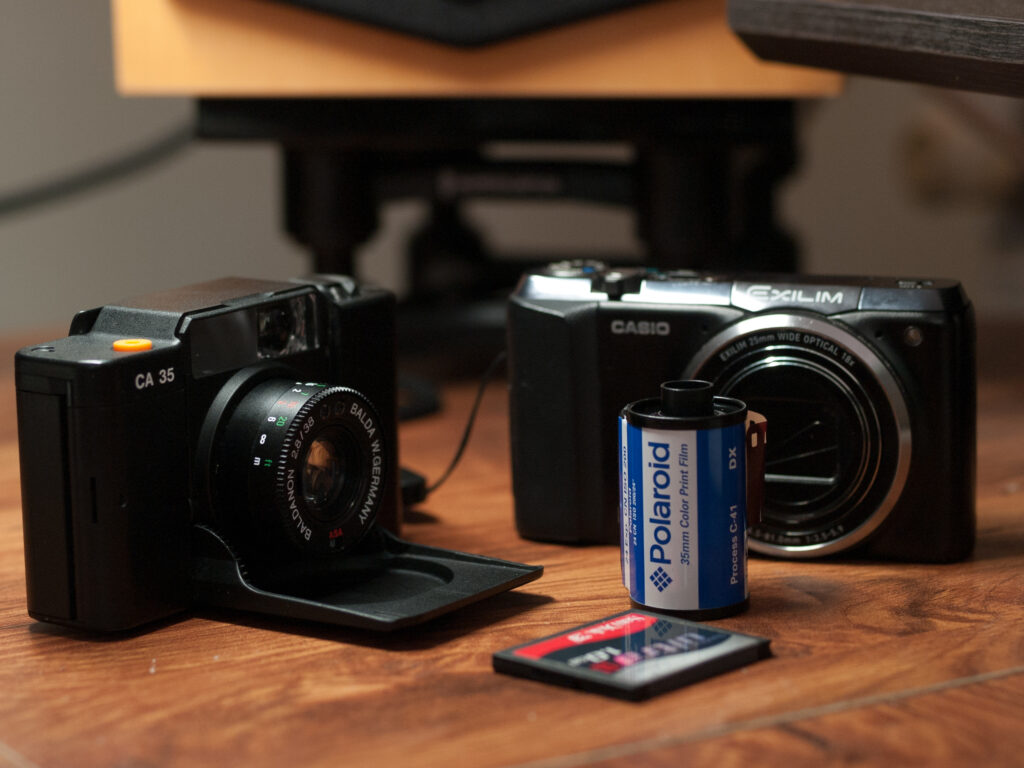
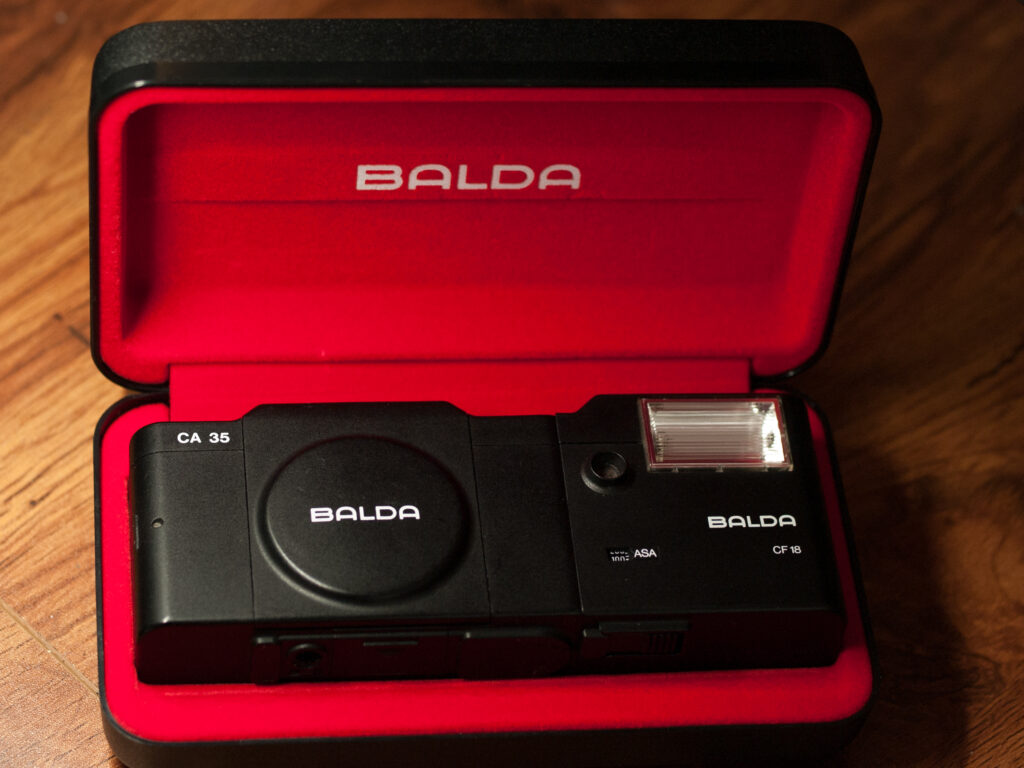
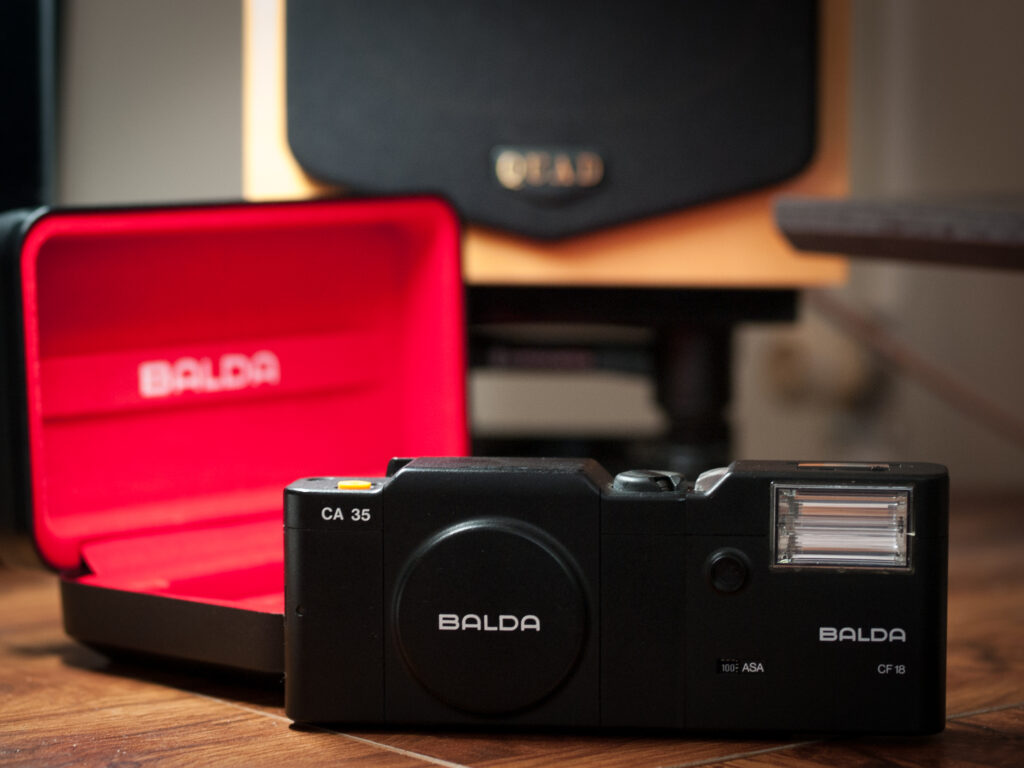
The focussing is smooth and nicely damped. The VF displays some icons which help you determine Focus, plus you can see the lens barrel in the VF as well to confirm what you have selected. The icons are simple and self explanatory; A Mountain (Infinity) Three men, Two men and One man – which is all pretty obvious. It’ll light up with an OK if the light is good on a half-press, otherwise it will display the Flash symbol (I haven’t used the flash unit).
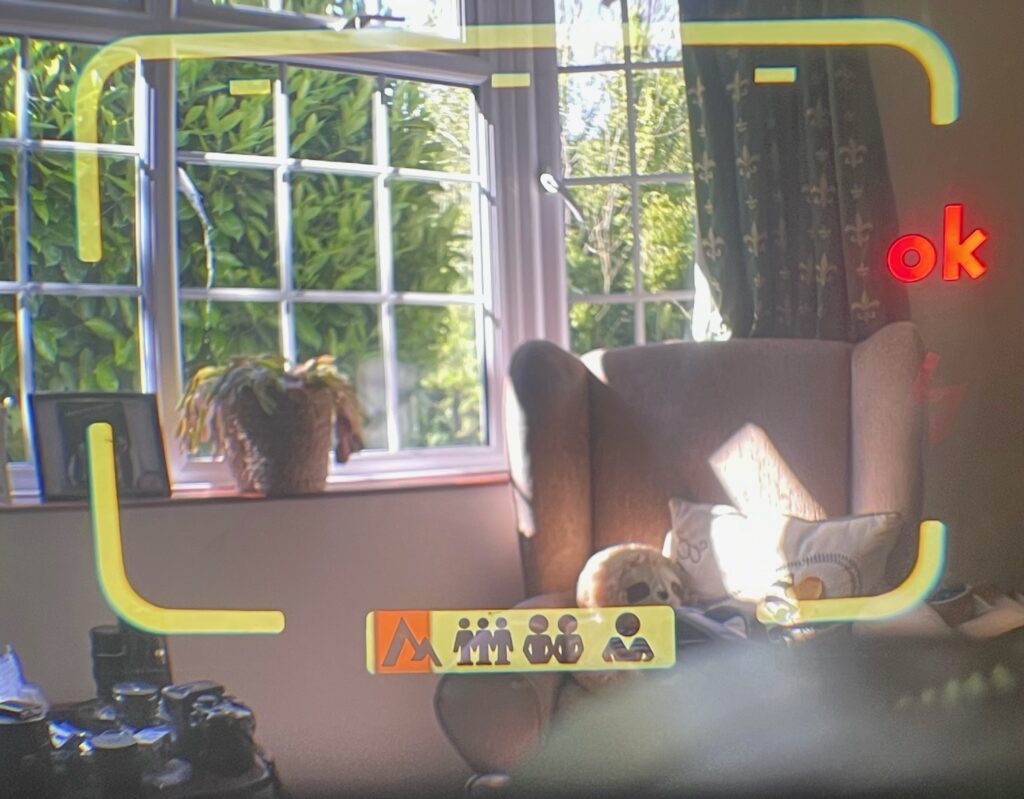
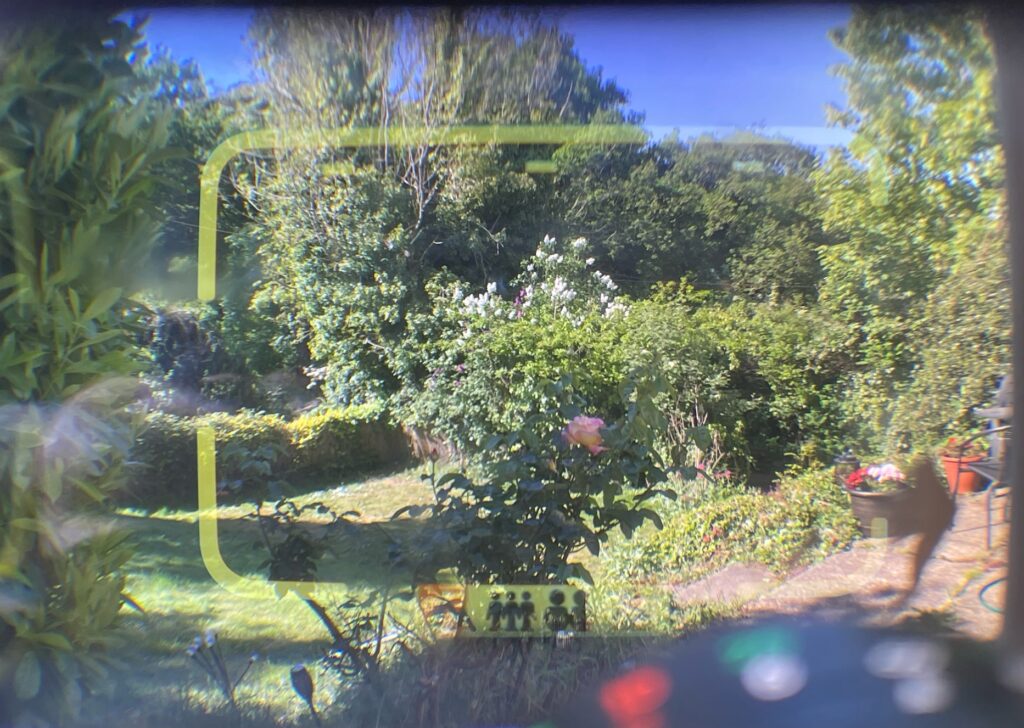
The lens has distance in Metres and Feet with red font at 10ft / 3 Metres, which is a sort of do it all distance, other Viewfinder Cameras have much the same (including my Durst Automatica)
The only control you have is over ISO, using the small dial built into the Balda CA 35 lens section.
One of my two favourite Films is Kodak Eastman Double X 5222. I had one roll saved but just put it in. Inserting film is a piece of cake, much less fiddly than other grander cameras I have. I then closed the back, wound on and went out, drove to a good place for photography; namely the Ruins of St. Peter’s Church in Arlesford. I’ve taken pictures around here before using the same Film with a Contax RTS II.
In use and Judging Distance
I snapped away, wind on, and a satisfying quality Click from the shutter. The camera and experience is so basic, even more basic than basic 35mm point and shoots I used back in the 80ies and 90ies. I just used that glorious Finder to compose, with determining distance being easy and second nature (I use paces to determine distance – 1 pace is 1 yard = 3 feet. Plus I am pretty good at judging distance anyway. For close up – again easy – distance from the tip of my nose to the tip of my index finger is 1 Yard – 3 feet – 0.9m – all clearly shown on the lens barrel.
I then drove home and stopped by The Mistley Towers to finish the roll.
Now as there is no Exposure Compensation and no way to determine what the shutter speed / aperture is, the only control I have is the ISO dial. I shot at box speed of ISO 200. In a scene where I’d want more or less exposure, I’d shift the ISO up or down a stop or partial stop.
Metering and Compensation when faced with certain lighting
The Balda CA 35 meter will always try and compensate giving a mid tone grey. So when faced with a situation such as this church facade below, it gave me a scene without much contrast, ok, the Diafine is partially responsible for this as it gives you flattish negative which is great for scanning with a lot of detail (usually) in shadow and high lit areas, but in this case it presented me with a difficult to work image – any shifting of values in Lightroom made it look ugly so I discarded it as the only poor shot on the 36 exposure roll.
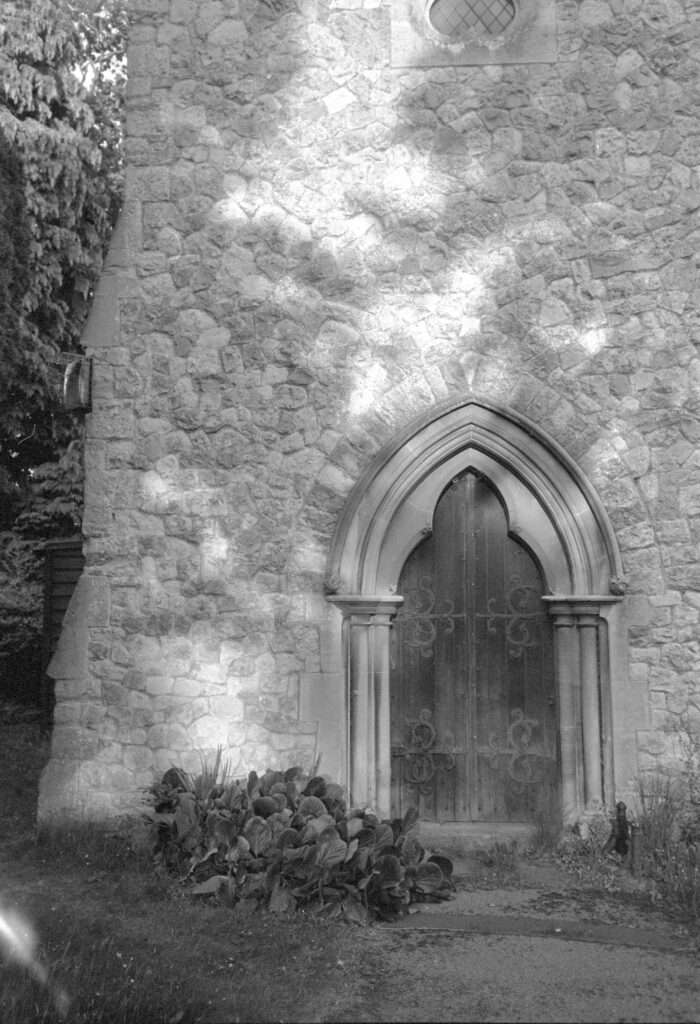
I had no yellow filter neither (anyone know how I could attach a filter onto this ?) So one has to determine exposure taking all of this into account and to use the ISO dial to compensate, so in this scene I wanted the shadow areas to be much darker, I should’ve taken away a couple of stops from the expsoure for this to give me deeper shadow. I could then work on the highlights afterwards.
I guess a more appropriate developer would’ve been better to use with this.
In scenes with very harsh contrast and direct sun in his face such as the snap of my son below, I should’ve upped the ISO a stop giving me a stop less exposure and – though the sun was directly hitting his face giving minimum detail anyway – but here it burnt out – as the meter was giving the back tracksuit bottoms a Zone IV. Normally I’d meter for the dark part of the bottoms and drop the exposure two stops, in future when faced with such a scene I’d veer on the side of caution and switch ISO a stop from 200 to 400. It’s either this or the cameras shutter speed wasn’t fast enough – either way in such scenes I’d have to shift the ISO.
As you can see from the colour image below (taken with my Kodak P880 I had with me – where I reduced the Exposure a great deal with the Exposure compensation Dial turning the background very dark, changing ISO would do more or less the same thing with the Balda.
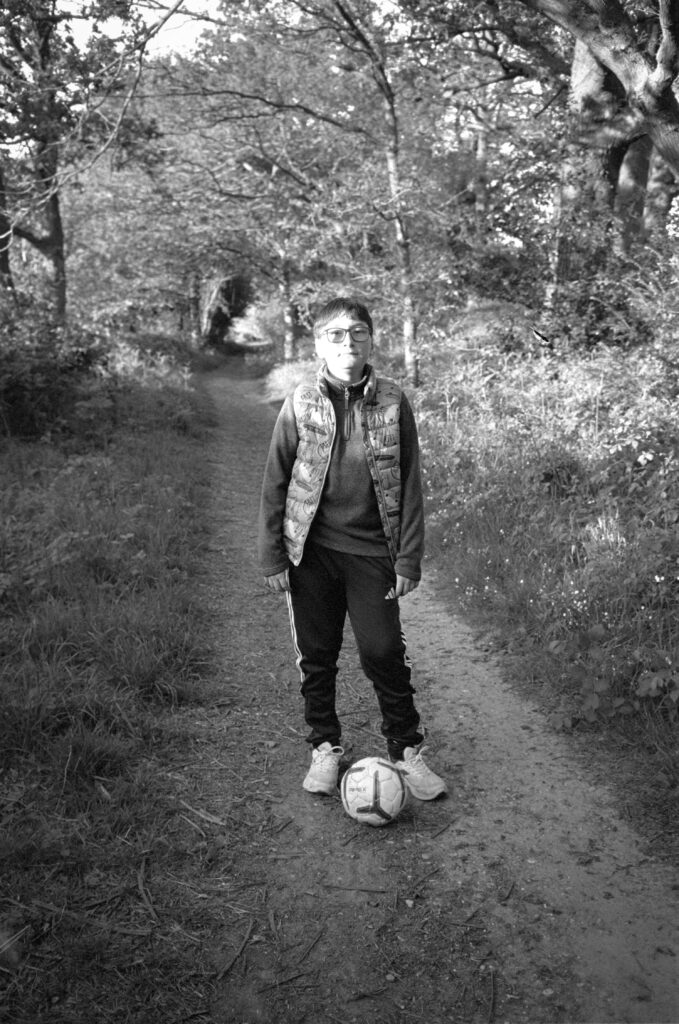
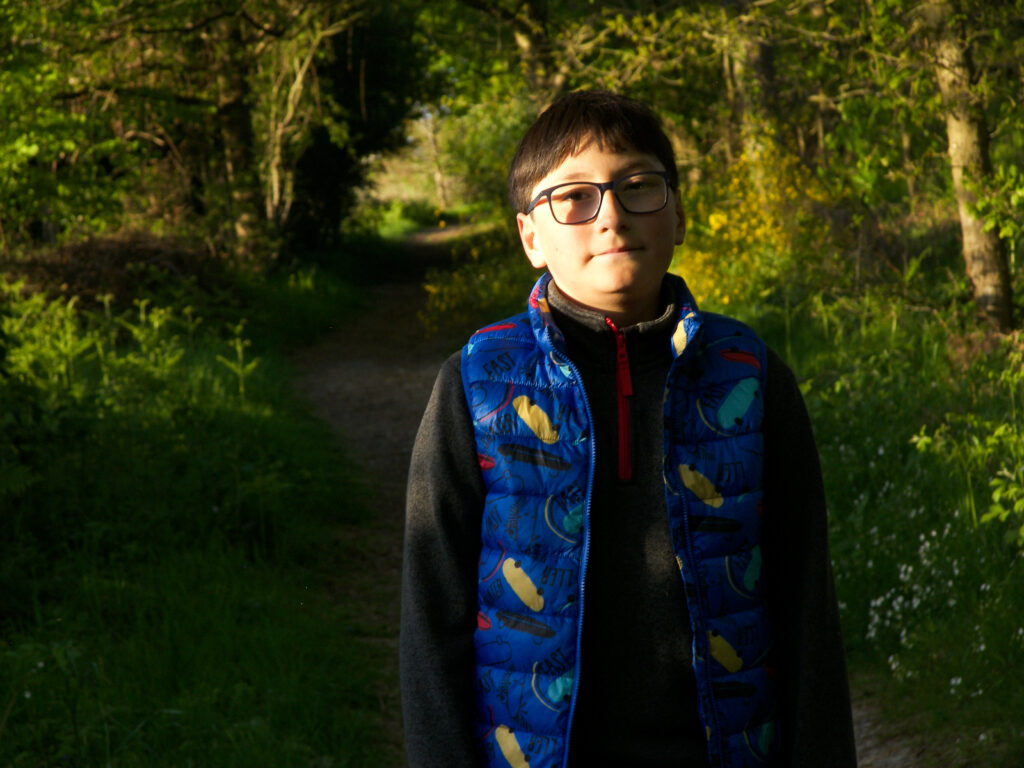
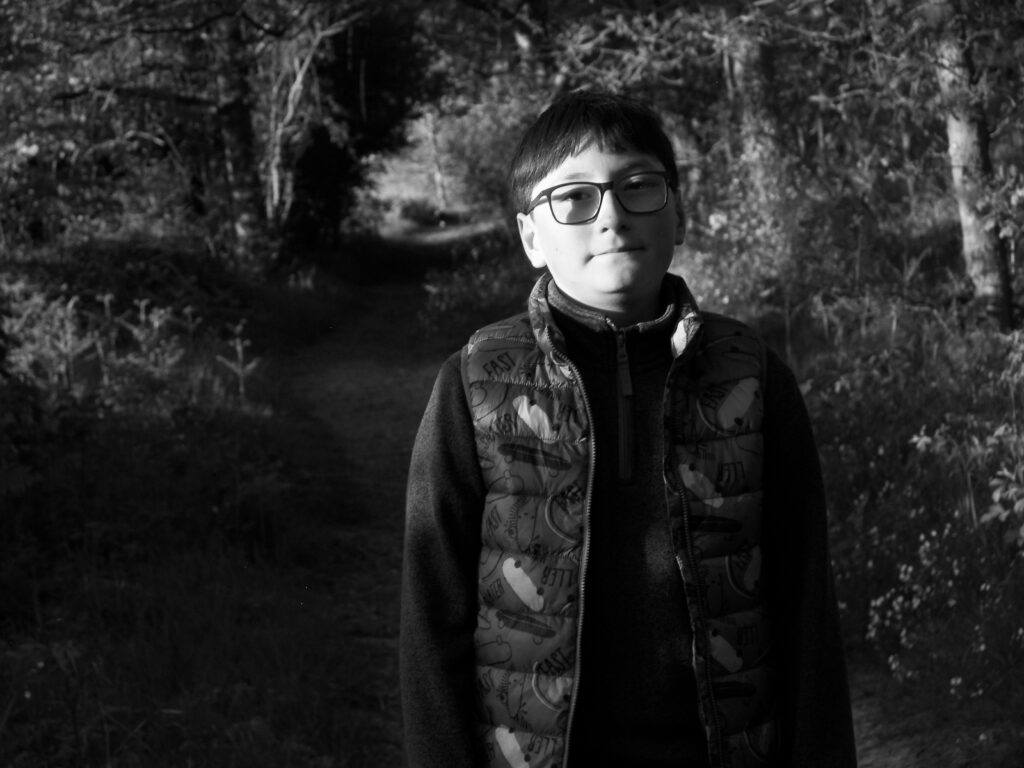
I then took the next shot and the meter, being closer in, handled it better. A lot more detail in the Film shot compared to the Digital., though some ISO compensation would’ve saved some more highlight detail. The photo below is unedited and a little tweaking would sort the contrast out.
the intention toward each shot differed though, the colour photo I was concentrating on the blue the yellow the green and the warmth – the B&W the play of light and shadow.
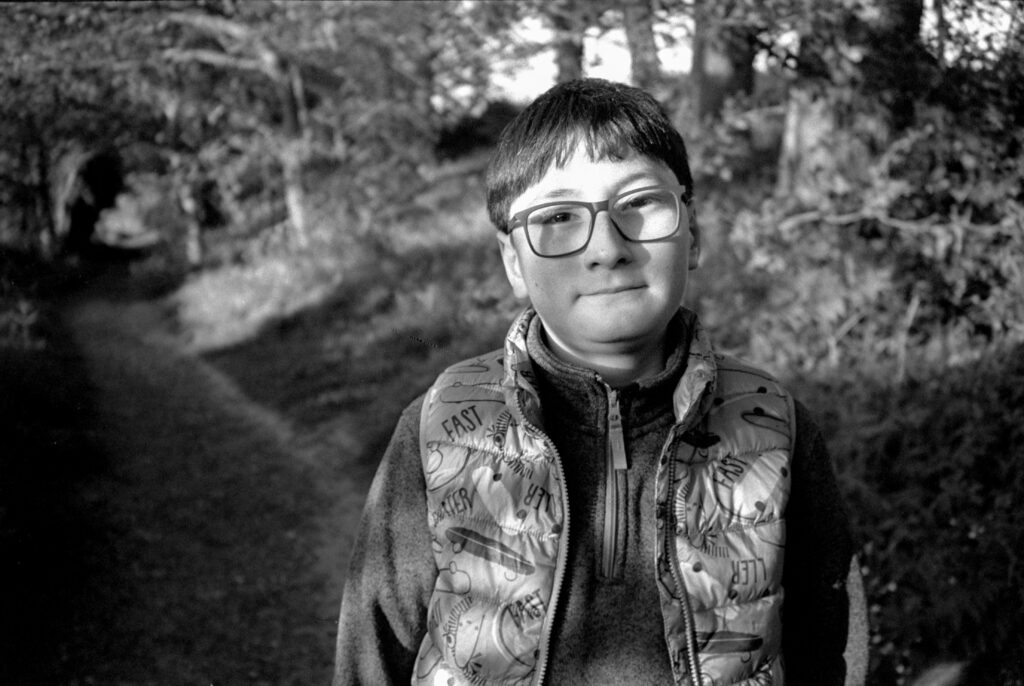
The Photos and some Comparisons with Colour (Kodak P880)
But generally the Meter nailed every shot. I was very very surprised at the hit rate as apart from these and the Church example, it was faultless. I include a selection here.
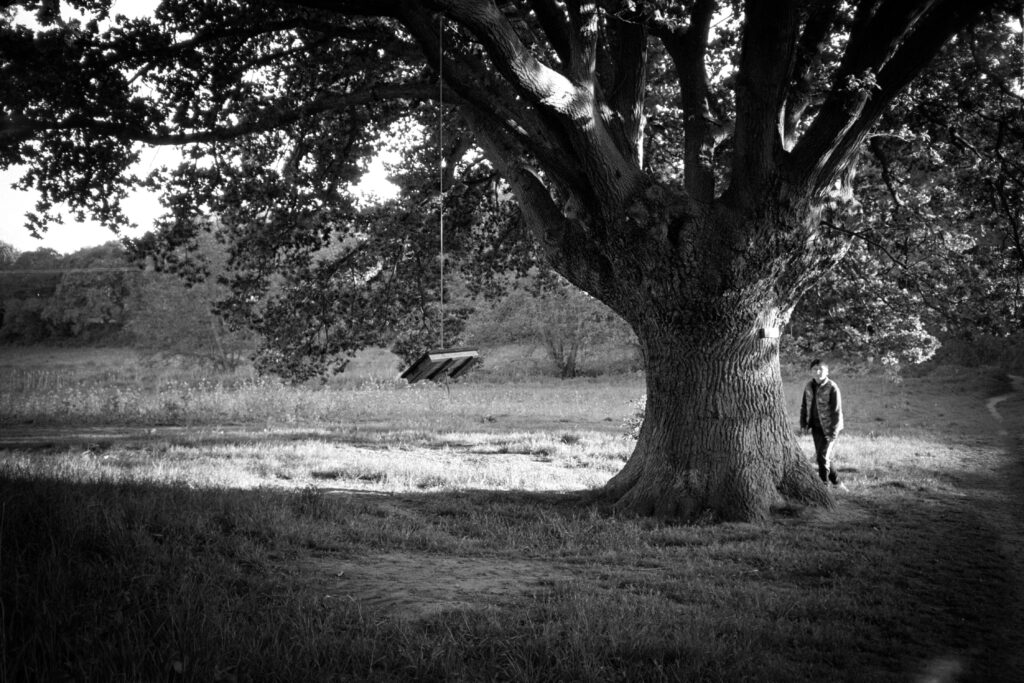
The above is my favourite Photo of the series. As you can see the colour one is very nice (The Kodak P880 is a very nice camera) a photograph of a tree in late spring afternoon – but the B&W just works better, my son walking into the scene as I was about to snap the tree adds that extra. The B&W Tones work well as the image is more about highlight and that’s what I feel.
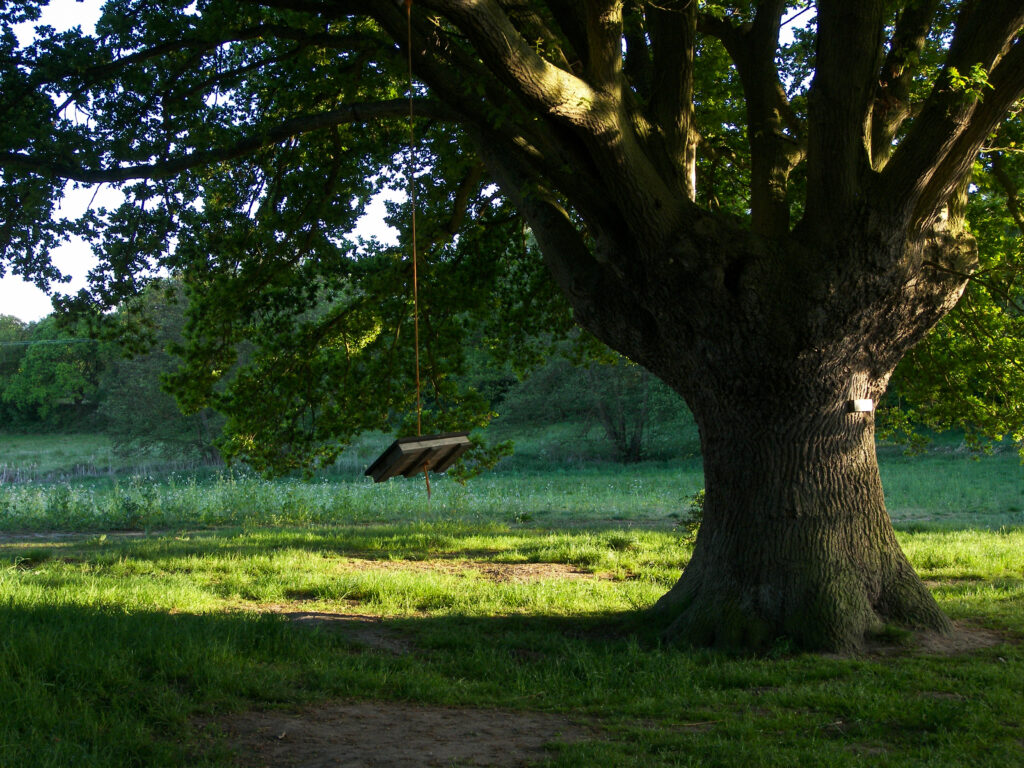
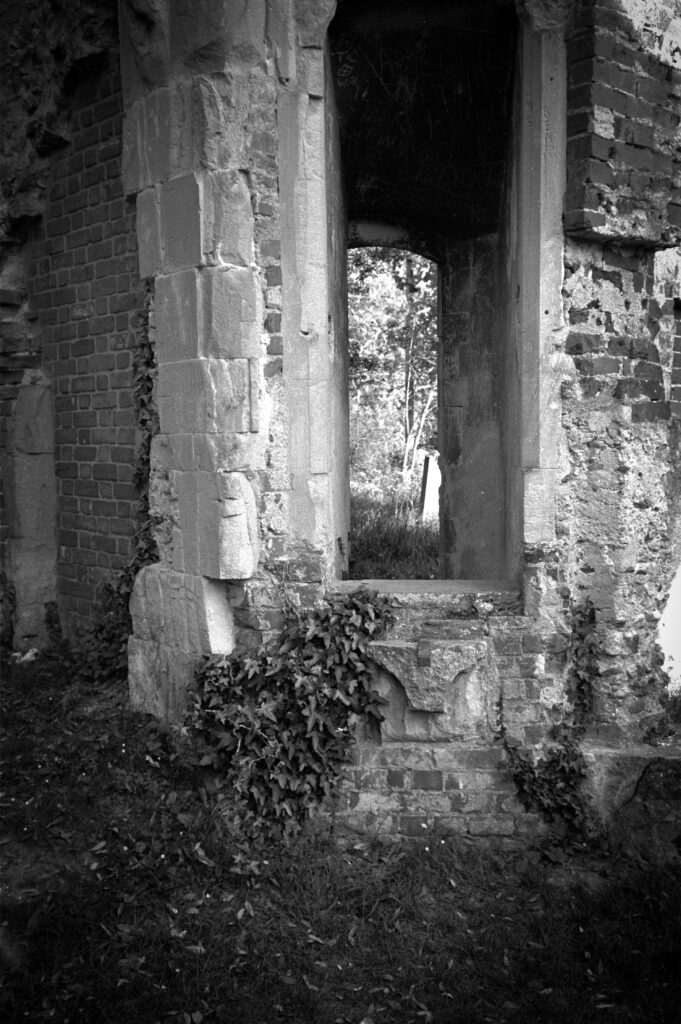
The B&W just works here, the colour Kodak P880 image below is pleasing (a walk in the woods) but lacks as much feel and is just a simple pretty scene.
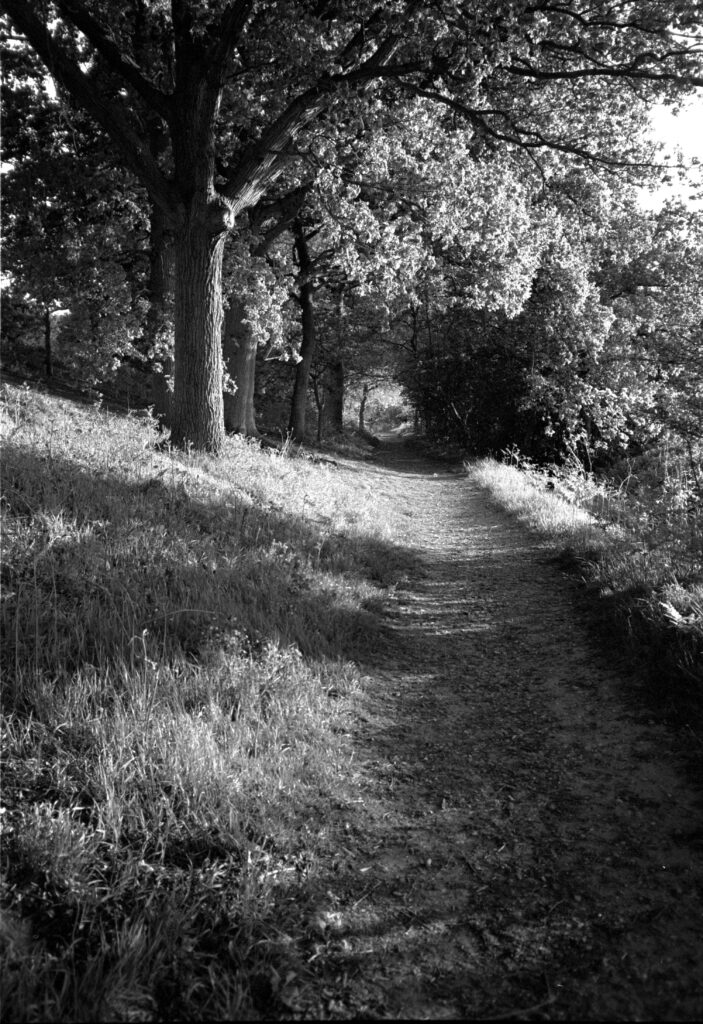
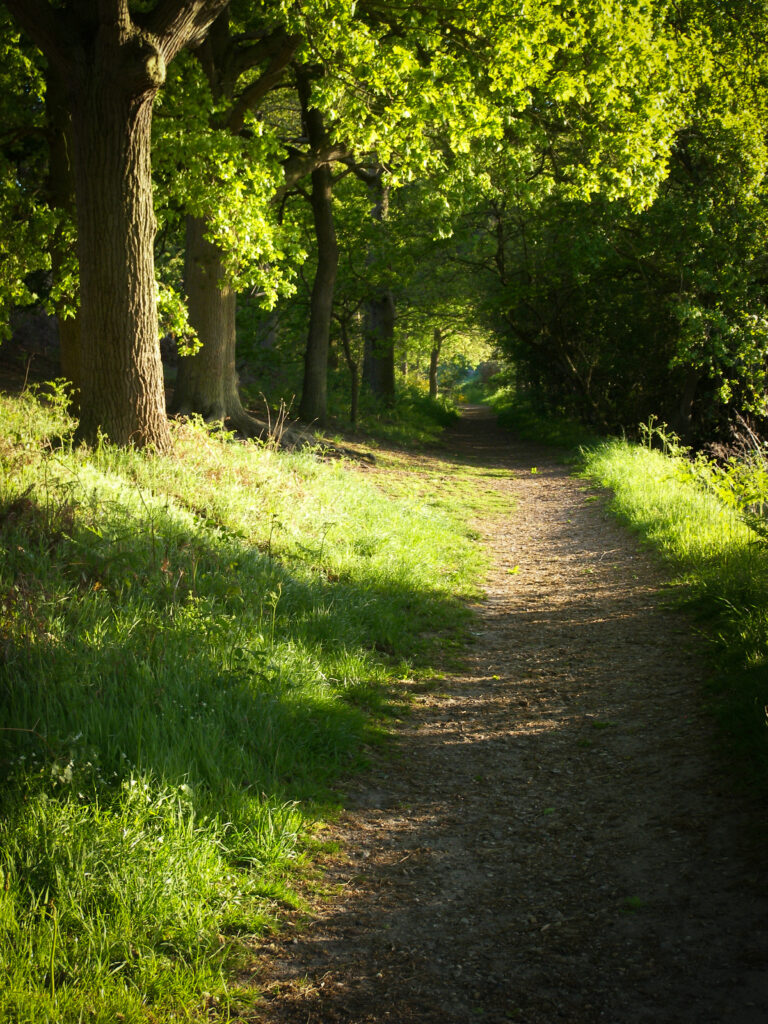
I like the photo below, but I could’ve taken tonal relationships into account – the green Ivy in B&W has the same tone as the wall, thus the colour image (below it) from the Kodak P880 is more pleasing in some way, though I was concentrating on the glow of sunlight on the texture of the wall, shapes formed and shadow, for the B&W . This is what I often aim for rather than a pretty scene of the inside of a ruined church as in colour with the ivy being the one of two main focal points. There’s something about light kissing a surface in B&W. The colour works in its own way, but what I saw and visualised for each differed completely.
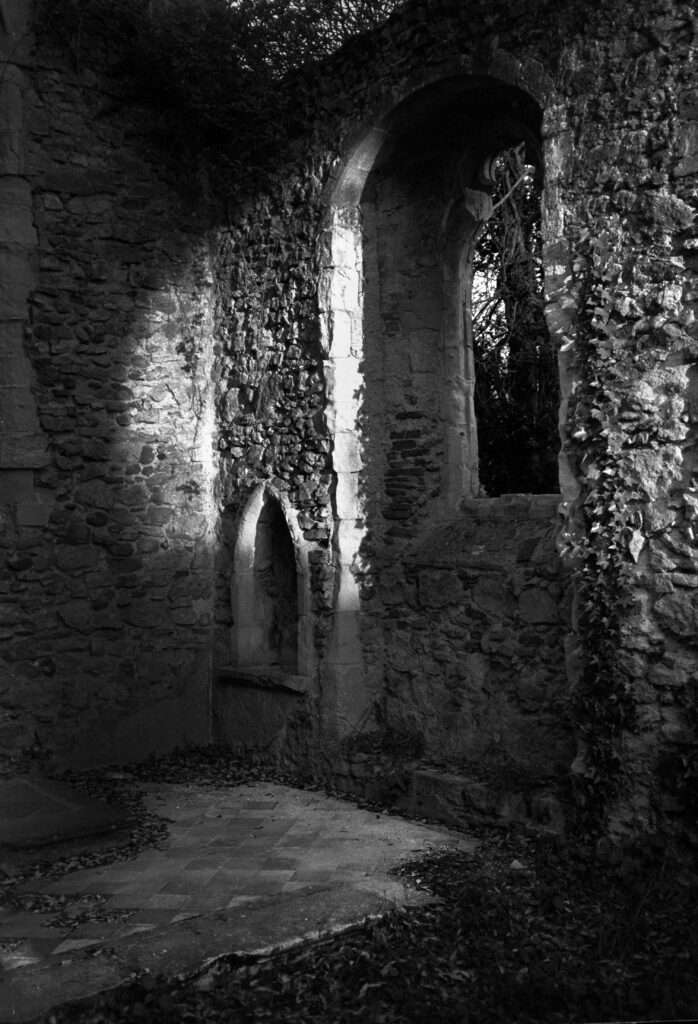
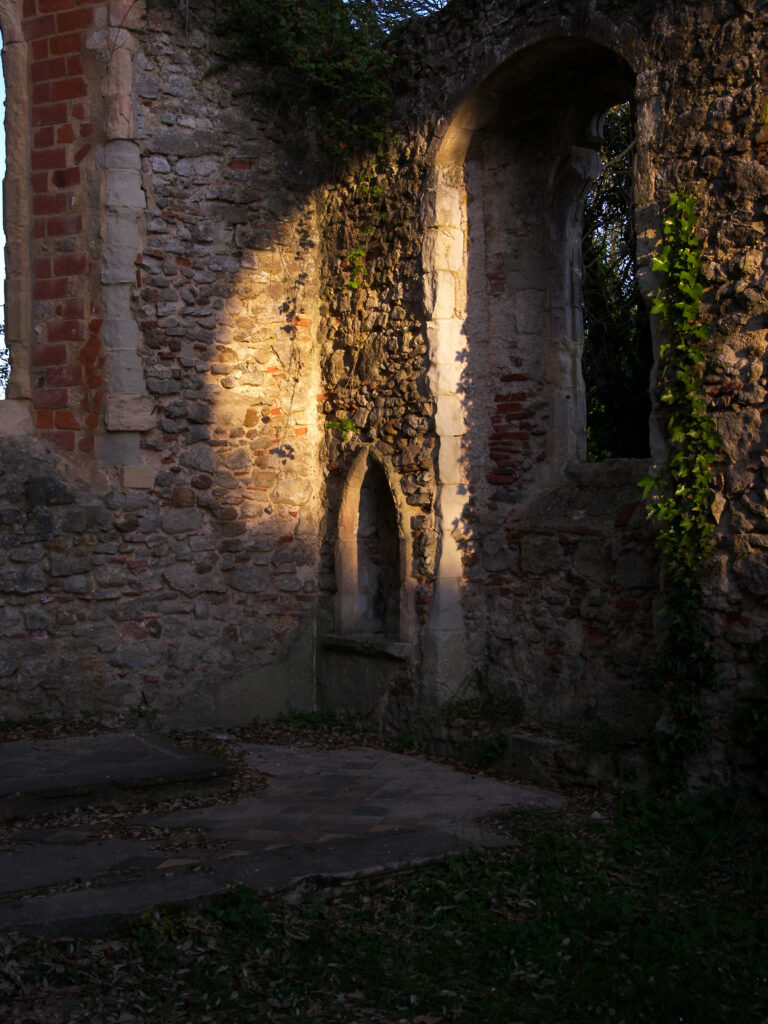
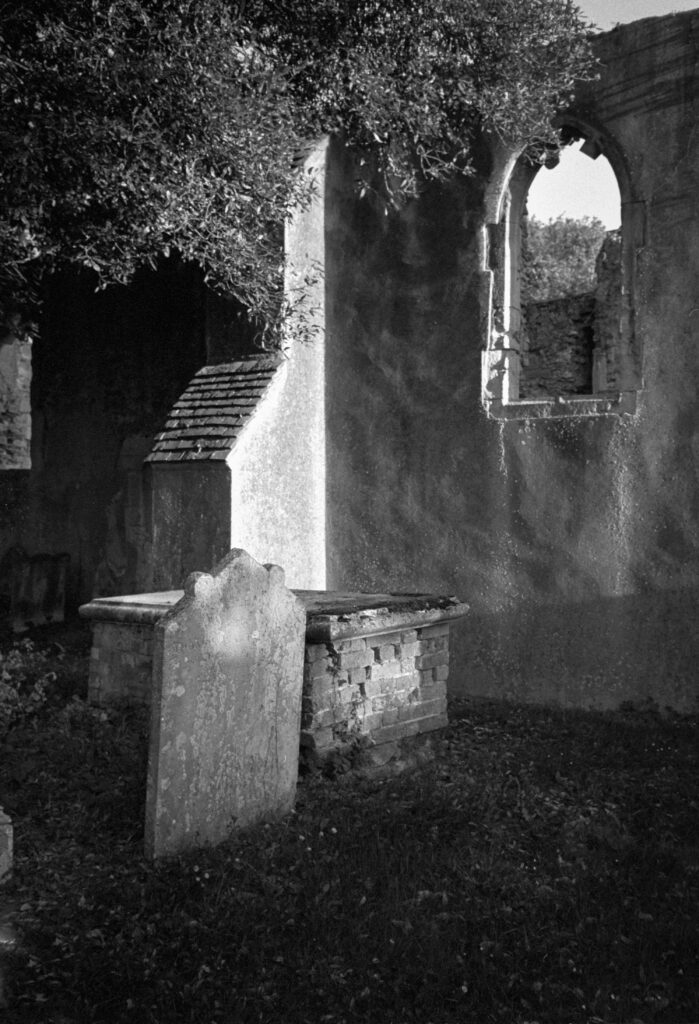
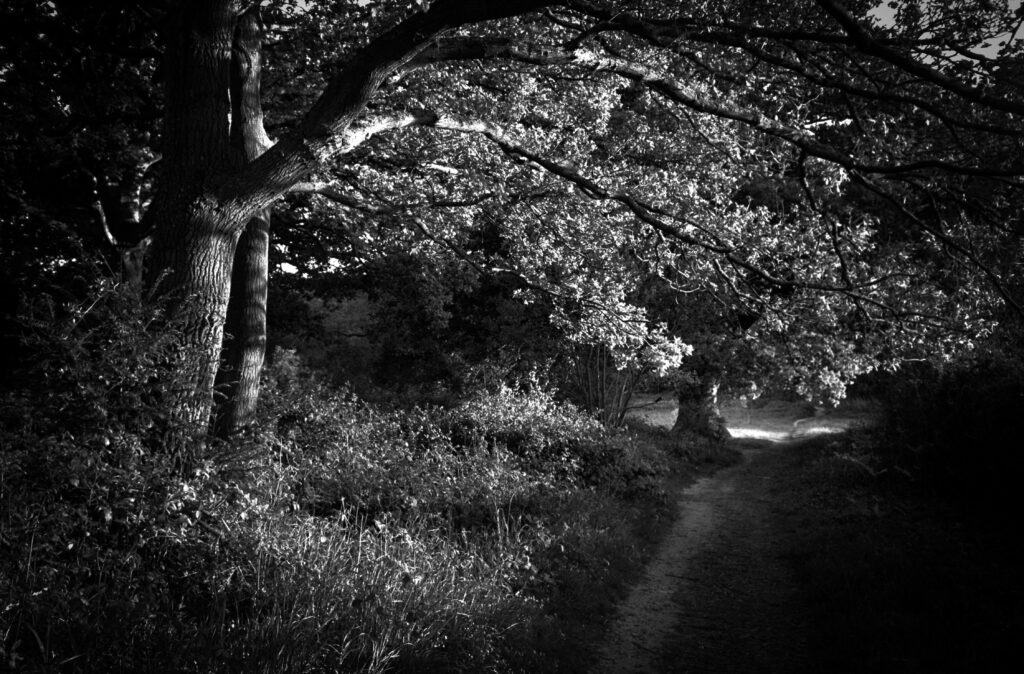
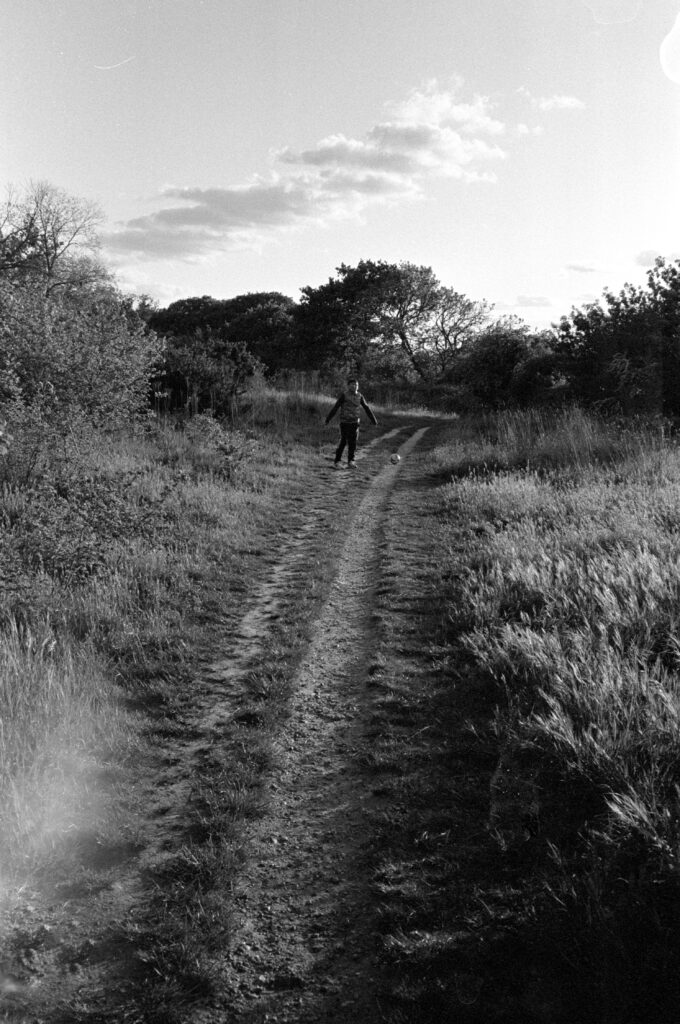
The Meter / camera when given a subject at 3 feet in bright light shoots at f16 or a similar small aperture. When faced with a similar scene in less direct light it opens up – so when shooting portraits (such as the close up portrait of my son 10 photos above) in less direct light, it opens up giving a very pleasing out of focus area.
As you can see, it’s razor sharp and contrasty!
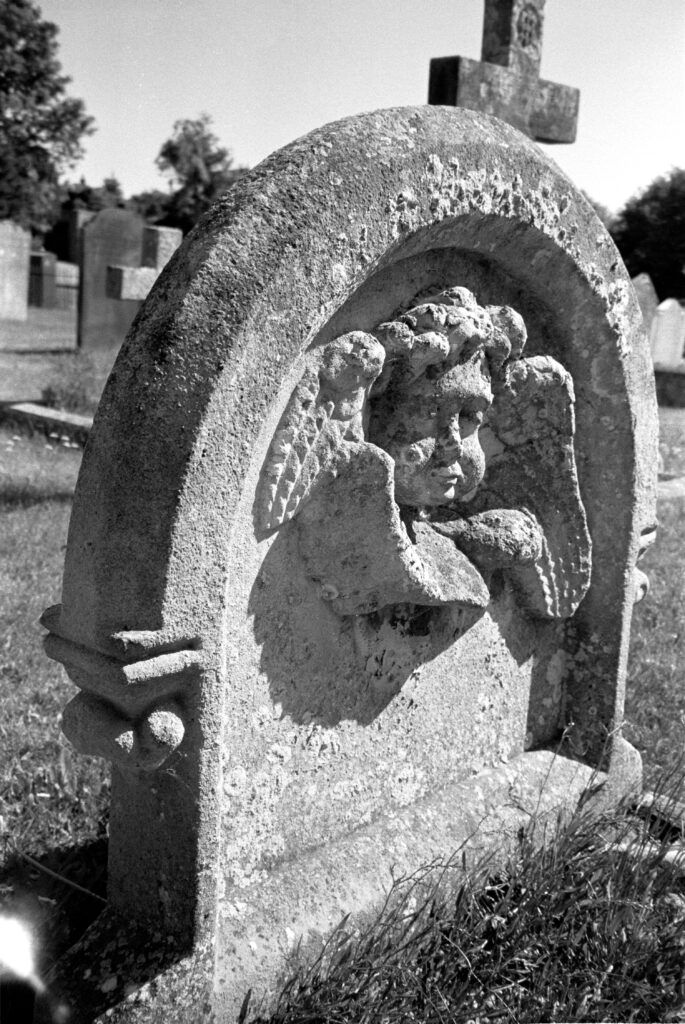
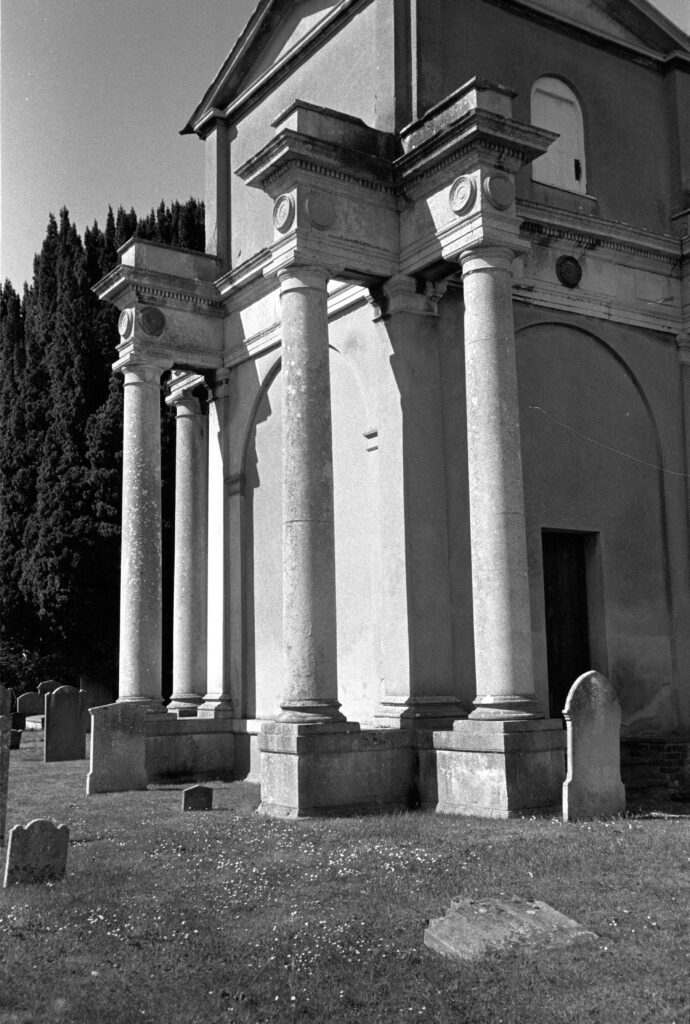
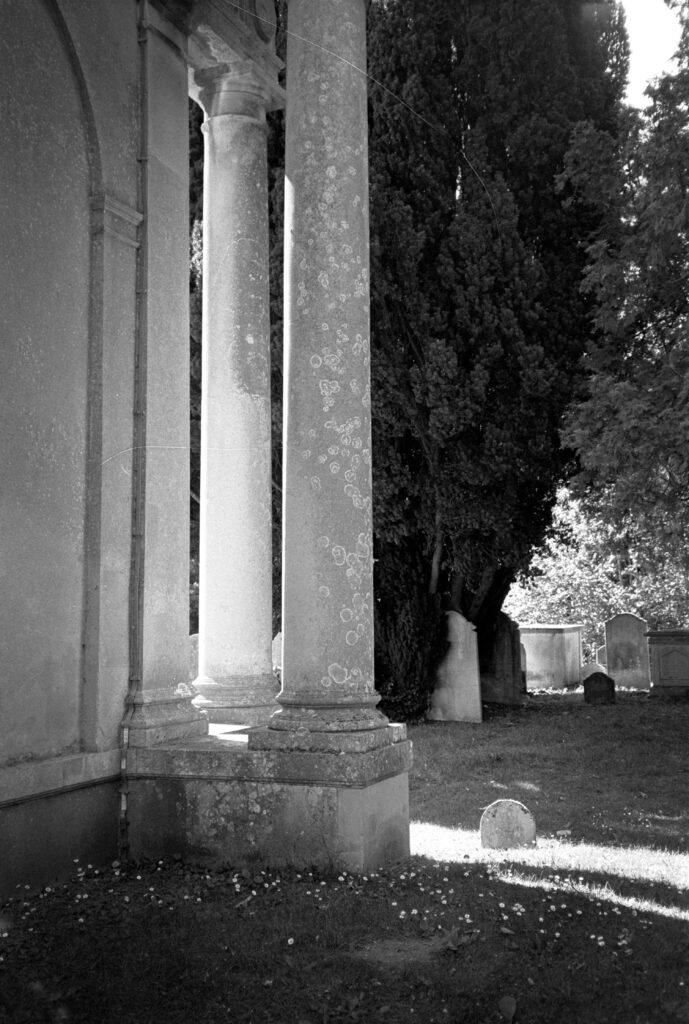
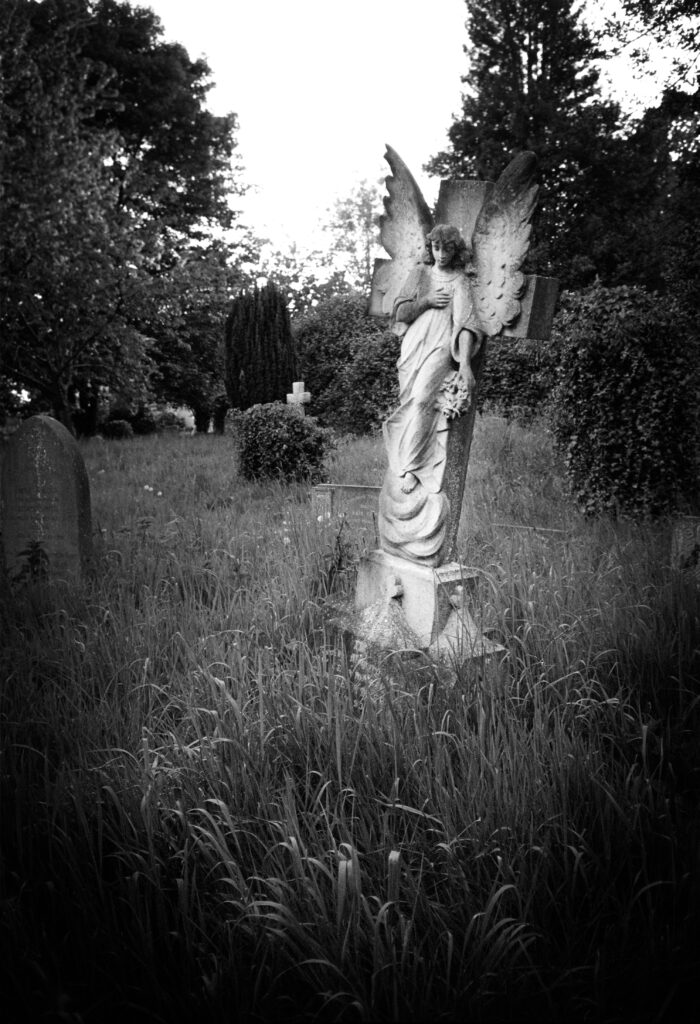
Flaws and Final Thoughts
In one word Fantastic. The Balda CA 35 has given me a pleasure of shooting because of it’s limitations and simplicity. It lets me concentrate on the composition using that lovely bright big finder and with full confidence in the meter and lens (with some obvious ISO tweaks as explained above). The lens is lovely, biting sharp with very pleasing contrast and it’s a very nice almost perfect snapshot 38mm focal length. Focussing is a doddle, almost instinctive making it quicker to shoot than a modern AF mirrorless.
The cheery on the cake is the feel and sound of the shutter button – so satisfying, and something which sets it apart from other cameras such as the Contax T and Minox.
Even being so small, it’s easy to handle and has a very nice feel to everything from the shutter sound, to the sound and feel of the wind on lever, to it in the hand. It’s easy to load and rewind. It is so nice to own and look at and small enough to put in a trouser pocket.
It is plastic though, and looks like a toy, a serious camera disguised as a toy! If you drop it, it will break, so be careful. And there’s no wrist strap, I cannot use a 3rd party one as it usually comes with a proprietary one which has a strange locking mechanism when inserting it into the slot. This is my only issue with the one I have. I am going to stick some grippy rubber grip tape on it for extra confidence.
There’s no way I can think of to attach a filter. These are crucial for B&W, especially a Yellow for me.
Mine has a small light leak in a corner – small enough to clone out easily but I hope it doesn’t get worse! The lens also flares a bit but I like it!
I wish I someone had made the exact same camera in metal – that would be glorious! Yesterday I shot a roll of Polaroid High Definition 200 in it and I like it so much it’ll be my companion for years to come; while it still works! Or rather the Contax T is the closest you can get to this in Metal, but something exactly as this in Metal.
Balda CA 35
38mm f2.8 Baldanon 4 element Tessar
Kodak Eastman Double X 5222 Shot at ISO 200.
Diafine/Bellinfoto Duo Step.
Scanned with a Konica Minolta Dimage Scan Dual IV
Digital camera used is a Kodak Easyshare P880 with Kodak Color Science CCD
Share this post:
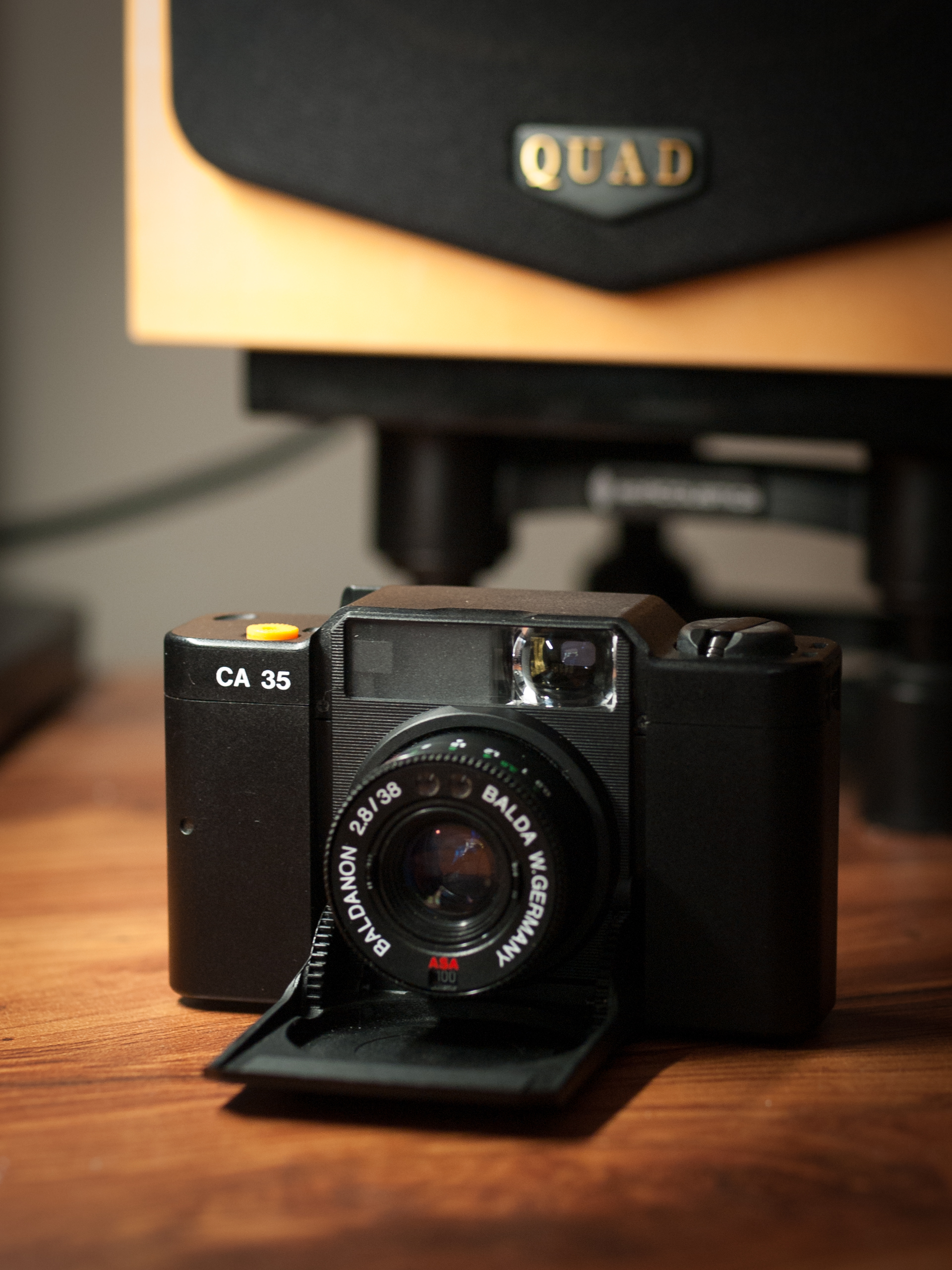
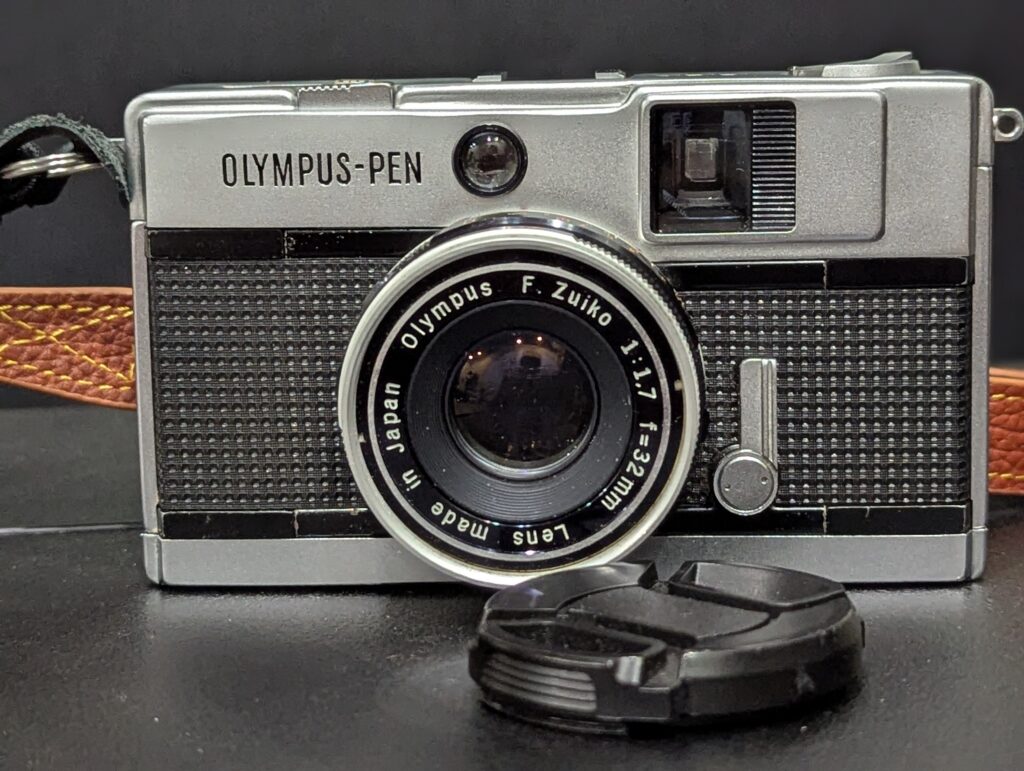
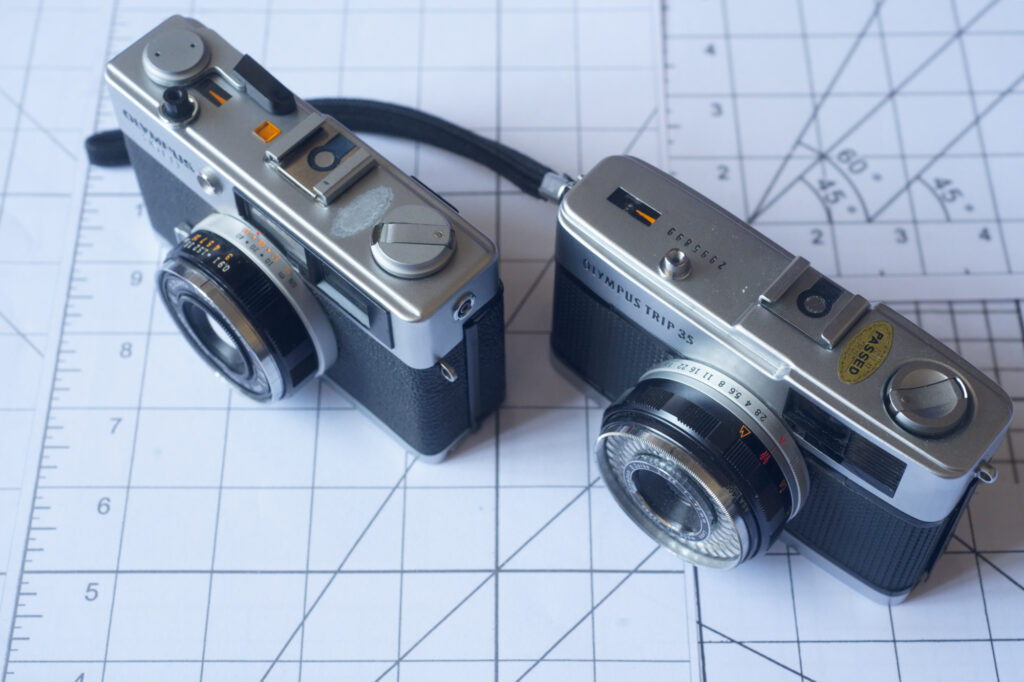
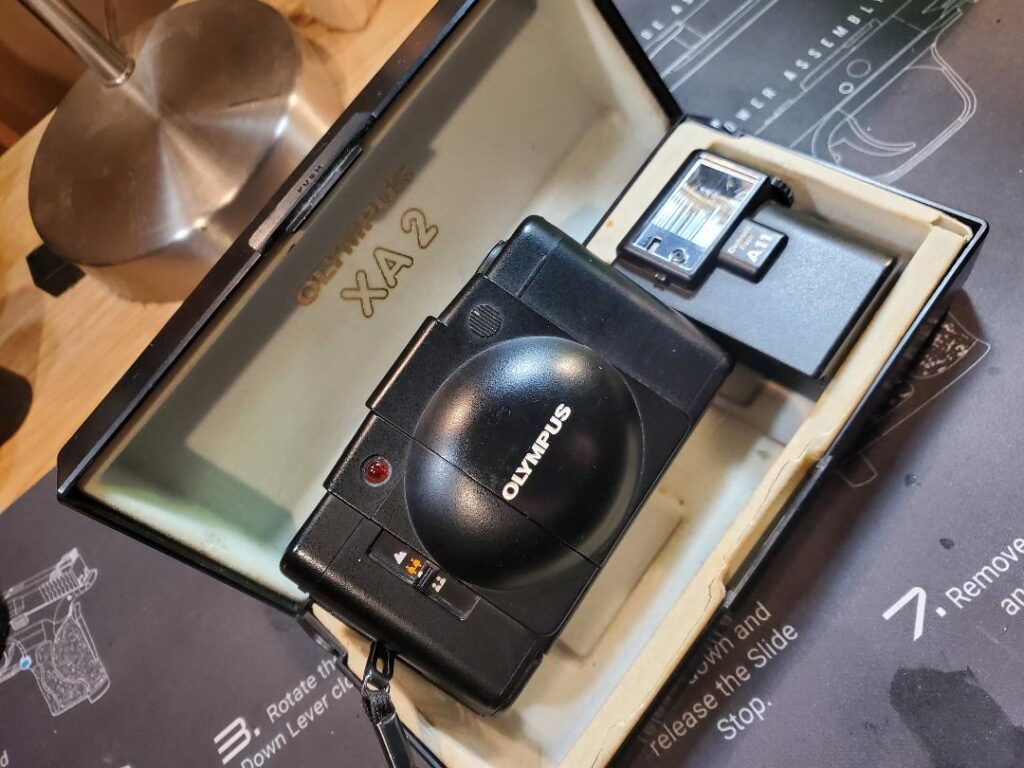
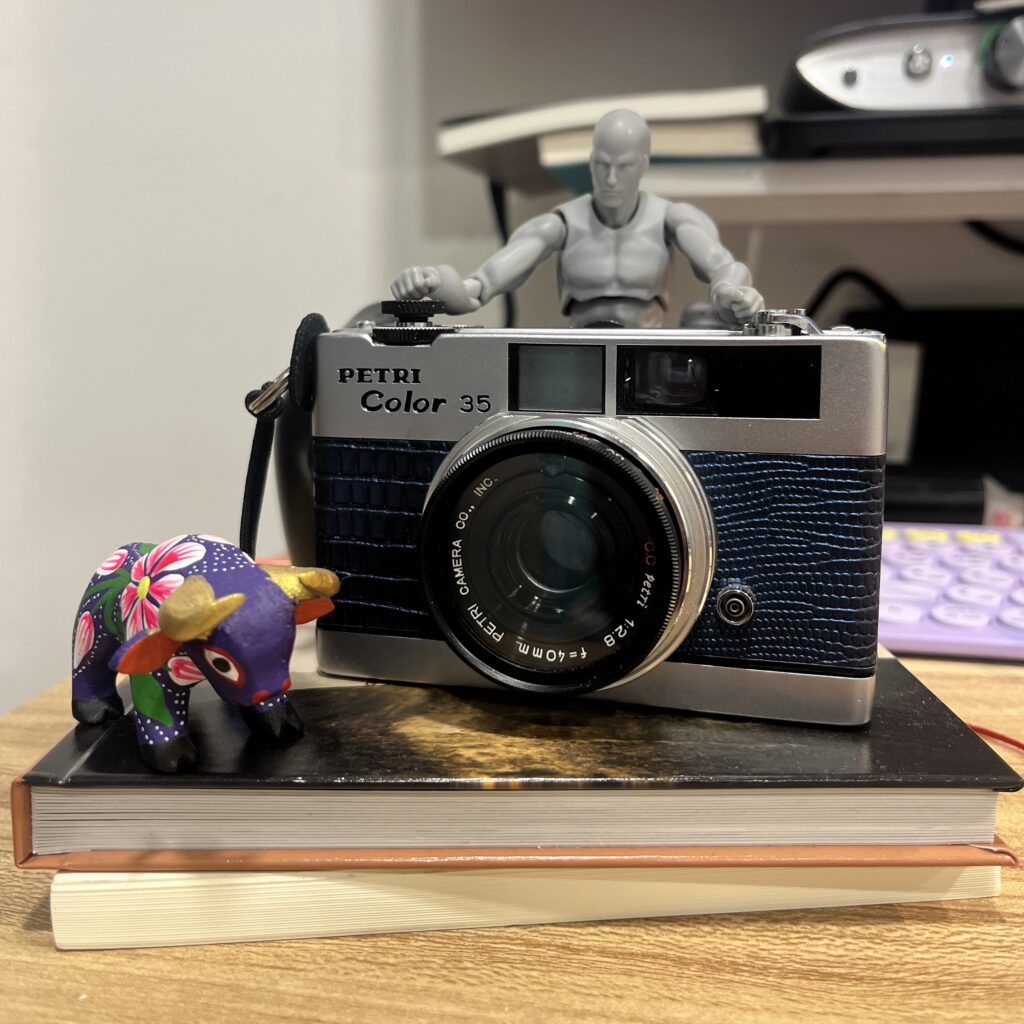
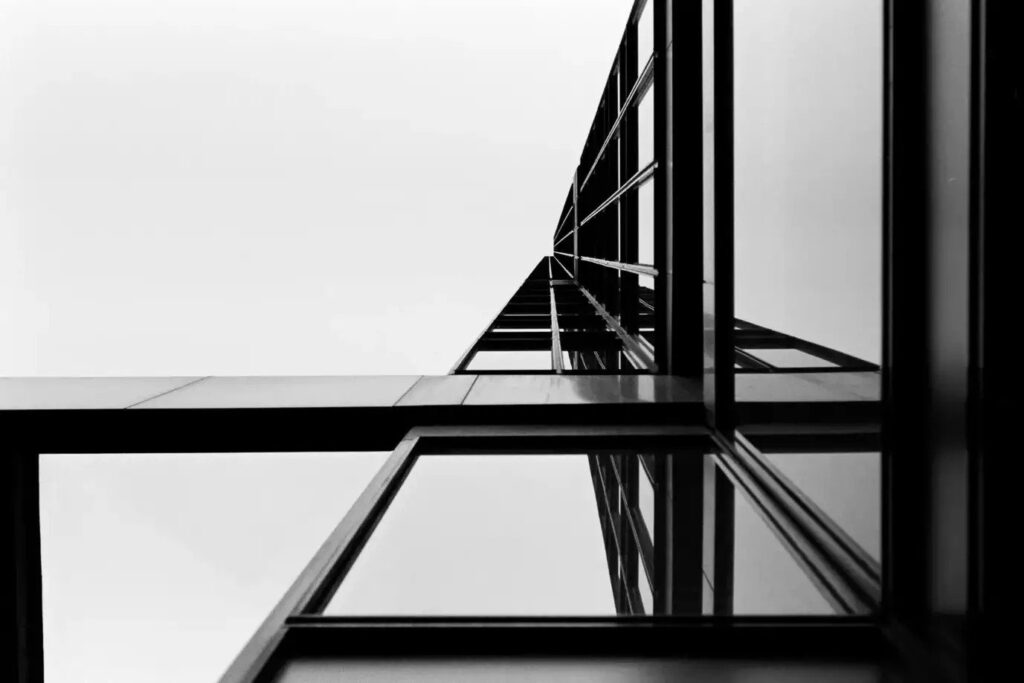
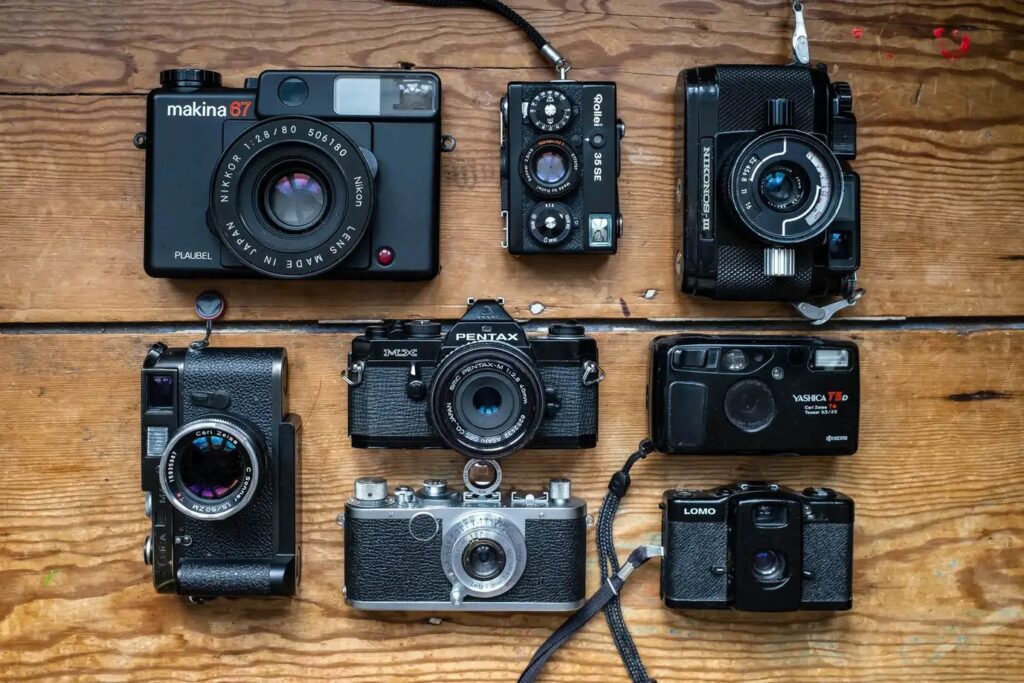
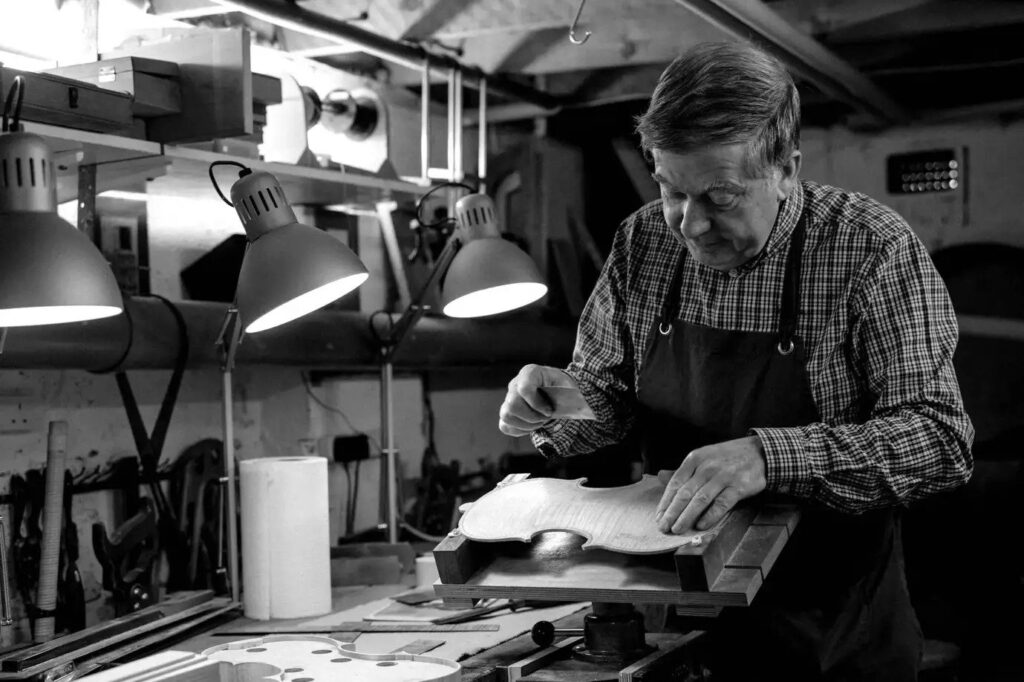
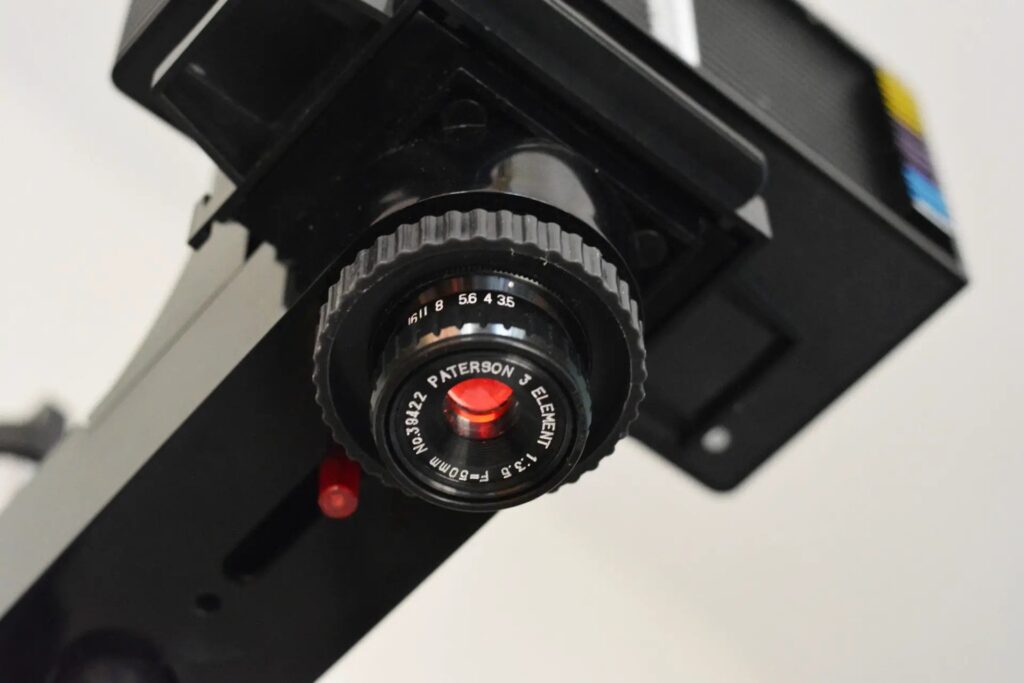
Comments
Martin on Balda CA 35 – A Fantastic little camera shot with Kodak Eastman Double X 5222
Comment posted: 09/06/2025
Gerard on Balda CA 35 – A Fantastic little camera shot with Kodak Eastman Double X 5222
Comment posted: 09/06/2025
I might do a contribution to 35mmc about that.
Thanks again for your fine article.